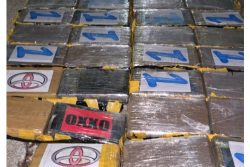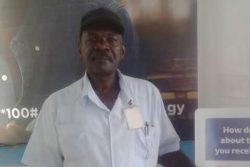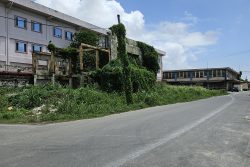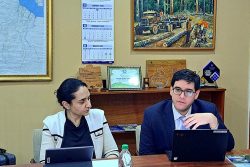Now that the Venezuelan National Assembly has passed a law naming Essequibo as the 24th state of Venezuela, and President Maduro has issued six decrees relating to the administrative measures to be applied there, the question arises as to how Caracas intends to go about incorporating into its territory what is, and always has been, our patrimony. At a practical level, as everyone recognises, that is only possible by the use of force. So what precisely is it that Venezuela proposes to do, and when does it propose to do it?
The first thing to be noted is that Essequibo covers a very large area, huge sections of which are not easily accessible. There is no network of roads down which tanks could roll, and other than along the littoral, settlements are scattered, sometimes with substantial distances between them. They are reached either via air, or along the riverways. Even allowing for the fact that invading forces might not bother initially about some large areas of forest despite the fact they might have settlements in them, occupation would still be heavy on manpower given the challenge of the terrain and the distribution of the population. At a time of instability in Venezuela one wonders if the government there would be willing to commit so many troops for what essentially would be a lengthy and difficult exercise when they might be needed at home.
This does not mean they would not occupy a portion or portions of Essequibo, but that aside for the moment, there may be other reasons why they might not take on the whole of the county in the first instance, at least. Apart from anything else, Brazil claimed the Rupununi in the nineteenth century, but in the 1904 Arbitral Award by the King of Italy it went to Guyana (or British Guiana as it then was). It is difficult to see the Brazilians, who up to now have not believed in a rectification of borders on this continent, accepting a Venezuelan occupation of this area in particular. Then there is the Iwokrama forest reserve which is managed by an International Centre under the joint mandate of the Government of Guyana and the Commonwealth Secretariat. Would Venezuela really want to engage directly with the Commonwealth at this level?
There are one or two other superficial observations which could be made such as the difficulty of flying aircraft in the interior of Guyana. It is not as if there is radar other than in places like Timehri, and that does not extend to the hinterland. Our bush pilots, therefore, have to be very familiar with the terrain, and to cover the whole of Essequibo the Venezuelans would be required to fly in personnel in the daytime, but without the benefit of our experienced pilots. One cannot think either that Venezuela expects – or ever expected – to get the whole of Essequibo; that is a negotiating starting point.
So if, hypothetically speaking, we might be talking about occupying portions of Essequibo, which parts would be involved, and how would it be accomplished? The area which has always most interested Venezuela would be a section or the whole of Region One, because that has an Atlantic façade which potentially would ground a claim to oil-rich marine areas. That said, the most accessible part of Guyana from Caracas’s point of view, would be our side of the Cuyuni, where Guyanese miners are constantly harassed and all manner of intrusions have occurred.
A straightforward invasion, particularly in Region One, would present the Venezuelans with some preliminary problems. In the first place, significant GDF bases are not located in Essequibo at all, and these would have to be neutralised first to eliminate any sources of military resistance. They might conceivably even direct attention to our two international airports to impede the arrival of any foreign assistance. Any action outside Essequibo, however, is effectively to take on Guyana as a whole, as opposed to ‘recovering’ the county as they want the world to believe. And for that, ideally they would need a certain international climate or at least support from key backers. They would too have to blame Guyana for something egregious, and although they have been trying hard to paint us as aggressors they have not yet ratcheted up much success where that is concerned.
But one possibility is that they operate in stages, starting in the Cuyuni, as has been suggested before, with marauding Sindicato miners displaced from their bank, whom they could then send troops after, or implement some other stratagem. It is significant, perhaps, that the arrangements in relation to the ‘annexation’ of Essequibo are centred on Tumeremo and San Martín, on the Venezuelan side of the Cuyuni. Where Region One is concerned, that is where most of the migrants from next door enter this country, and we really know nothing about them – which is not the same thing as to say that the majority are not genuine. But we have no way of knowing how many are gang members say, sent in to create incidents when it suits Venezuela’s programme for acquisition. At a minimum, we should not be issuing identity cards to them.
All of that said, given the illogicality which reigns in Caracas circles, it is very difficult to predict either what will happen, or when it will happen. Certainly when Diosdado Cabello presented the bill about Essequibo to the National Assembly, he said that body would exercise legislative power, until the “dispute” with Guyana is resolved. In terms of timelines, exactly what that means, however, is unclear. Then there was the announcement by President Nicolás Maduro on Thursday that the Great Venezuela Housing Mission was to construct homes in ‘Guayana Esequiba’. Not immediately it seems, because the first 120 for ‘Venezuelan Essequibans’ are to be built near San Martín “on the edge of the Cuyuni River” – but in Venezuela. Is this some kind of pretence game, or does it mask something more ominous?
What is difficult to read is how Venezuela sees the situation as developing, and whether if it does manage to install itself in a part of Guyana, it would be with the aim of facilitating ‘peacekeepers’, say, so the area would really be seen by the outside world as one in dispute and in need of bilateral negotiations.
Whatever the case, Guyana is in danger and requires an across-the-board response. President Irfaan Ali has certainly been doing what he can at the diplomatic level, but the country should be directing its efforts at all levels, and not just official ones. Guyana did go to the Security Council on Friday, but no immediate action followed the closed-door session. The Independent reported some diplomats as saying they would need to check with their capitals about a possible press statement.
A critical thing is to belabour the international community with accurate data on the Geneva Agreement, and not leave Caracas unchallenged on the subject. Perhaps Messrs Ralph Ramkarran or Cedric Joseph could be approached to write a detailed account of Geneva and its terms, as well as a synoptic version for distribution purposes. The government in Caracas is constantly promoting the fallacy that we are in dereliction where Geneva is concerned, and they seem to have persuaded any number of leaders in the international community that this is so. It is on this basis that they have convinced some governments that bilateral talks are what is required, because this is what Geneva lays down.
The approach can take the form of serious articles in academic publications, briefer background papers for media outlets, social media statements, letters to newspapers which have covered the issue, and, of course a diplomatic onslaught. There is something wrong when President Lula proposes, as he has done, that the pro tempore President of Celac, Ralph Gonsalves, should serve as mediator to discuss the controversy with both Venezuela and Guyana, and that Brazil should be the venue. Mr Gonsalves’s biases are well known and deplored here, but someone in Takuba Lodge should be organising a démarche to Itamaraty without delay. The mantra Guyana recites everywhere without cessation should be that it is at the ICJ because of Geneva, not in spite of it.
Then there is the Indigenous dimension. We have a great advantage in that our representative at the UN is Carolyn Rodrigues-Birkett, who is herself an Amerindian, born in Santa Rosa, Essequibo. She will already be familiar with the indigenous organisations attached to the UN and OAS and should be afforded extra manpower if she needs it to approach them about the danger to the nations of Essequibo, especially those on the border, by Venezuela’s ‘annexation’. To its great credit, the APA here has asked that more emphasis be placed on ensuring the Indigenous peoples receive accurate information which is easily understood by them, since many do not understand the complex information publicly available because English is not their first language. It went on to say that it was prepared to support the authorities to simplify information.
The government has commendably brought in the opposition in the light of the danger, and it should extend this to all groups with which it has been at odds in the past. It should accept the APA’s offer, and should solicit their intervention to contact international organisations concerned with indigenous people to alert them to Venezuela’s actions and the threat that these represent to the original inhabitants of this land. What applies to the Indigenous people’s organisations, also applies to those with environmental connections, who can alert international bodies to the possible peril to our environment. Venezuela’s appalling record in the mining arc has been covered by various outside organisations. The Commonwealth particularly should be alerted in the light of Iwokrama.
Then there is the appeal to the academic level, particularly in the Latin world where in some places it exerts a bit of influence on politicians. Some bizarre histories of the boundary have been appearing in the Venezuelan press, and the fastest thing for us to do at present is to get a translation of what is still the best introduction to the topic, written by Cedric Joseph in Caribbean Studies in 1970 and 71. It should be translated into Spanish and Portuguese by professional translators, as well as being distributed in the original in English-speaking areas (after the requisite permissions have been granted). It should be sent to teachers in those universities which deal with boundaries or international relations. It could also be distributed at the UN along with anything written here about Geneva.
Diplomatically speaking we should be snowing the international community, and the impression is given that we are not. Of course, our diplomatic resources are very limited, and we need to concentrate on a few critical countries, such as India and South Africa which are in both the Commonwealth and BRICS. For the rest, the UN is our easiest route to reaching a large number of countries, and its personnel should be beefed up. Apart from that, the Guyanese diaspora should be pressed into service to bring the matter to the attention of the authorities where they live. In the end, an unsympathetic approach to Venezuela’s atrocity internationally, will give our neighbour pause for thought.
Most people will think that a defence pact with a military power is our best safety option. That may possibly be the case and is presumably being explored by the government. Even if it were viable, however, it would not happen immediately and much would depend on what form it would take before it could be recommended. In the meantime, Guyana should be doing all that lies in its own power to counter Venezuela.








